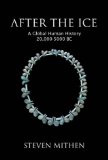Archaeologists, both amateur and professional, struggle with the vast gulf of time that separates them from human activities in the distant past. The architects of the pyramids in Egypt, for instance, are at least a millennium further from the era of Christ than we in the 21st century. How then can we conceive of the impossibly remote Last Glacial Maximum, clocking in at 20,000 BC?Anatomically-modern humans, the same in every physical respect as we are today, evolved perhaps 100,000 years ago, and for 80 millennia eked out a living in the harsh conditions of the Ice Ages. Soon after 20,000 BC, global warming began, and the great ice sheets began their retreat. Fluctuations in climate brought about immense changes in animal and plant species and their distributions; with them came a wholesale change in the character of human societies. By 5,000 BC, says Mithen, the foundations for the modern world were laid. Farming, a sedentary lifestyle, craft specialisation and social stratification all emerged in the period running up to the zenith of the Neolithic. "Nothing that came after -- Classical Greece, the Industrial revolution, the atomic age or the Internet -- has ever matched the significance of those events".
Many books have been written about the Mesolithic and Neolithic ages, yet none of them has attempted anything as ambitious as this book. Mithen has aimed his work at the widest possible readership while maintaining an appropriate level of academic rigour; readers who wish to follow up on any of the themes, sites and periods discussed can refer to his comprehensive bibliography. The chronological and geographical scope of the book is immense, as its subtitle suggests. The true ambition of the book, however, is to close the gap between ourselves and the distant past. He accomplishes this through the introduction of a time-travelling explorer, whom he names John Lubbock after the 19th Century anthropologist and author of "Prehistoric Times". Mithen's explorer, however, is equipped with the modern theoretical tools and archaeological knowledge his Victorian namesake lacked, recognising our ancestors as intelligent humans no different to you or me, rather than savages with childlike minds. Throughout the book, the modern Lubbock encounters the inhabitants of archaeological sites, witnessing their daily routine, the struggles they face and the incredible innovations which form the basis of the modern world.
This metaphor - excavation as travel - attempts to convey Mithen's own experience of archaeological investigation. When exploring the past, one is, as Paul Theroux said, "a stranger in a strange land". Despite this strangeness, the experience of being "other" to the inhabitants of the past, Mithen succeeds in underlining how similar our ancestors were to us, a theme carried over from his previous work. In "The Prehistory of the Mind", Mithen argued that human achievements can be attributed to the evolution of a peculiar kind of mind, in which the barriers between cognitive modules were broken down to produce a mental toolkit that was "cognitively fluid". The birth of that stone-age consciousness produced an adaptivity with much greater responsiveness than the glacial pace of physical evolution, and saved humankind from going the way of the mammoth. Our ancestors survived cold, drought and starvation by remaining adaptive to change. "After the Ice" is the story of that survival.

